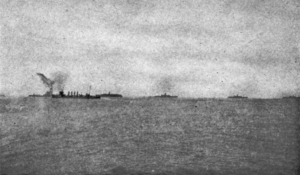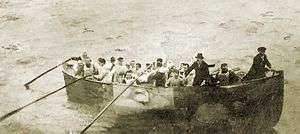SS Antilles (1907)
- This article is about the American passenger-cargo ship sunk by a U-boat in 1917. For the French cruise liner wrecked in 1971, see SS Antilles.
 SS Antilles torpedoed while operating as the U.S. Army chartered transport Antilles. | |
| History | |
|---|---|
| Name: | SS Antilles |
| Operator: |
|
| Builder: | William Cramp & Sons Shipbuilding Company |
| Launched: | 1907 |
| Fate: | Sunk by U-boat, 17 Oct. 1917 |
| General characteristics | |
| Type: | Passenger-cargo ship |
| Tonnage: | 6,879 GRT |
| Displacement: | 10,500 (normal coal supply) |
| Length: | on load line: 421 feet 11.5 inches (128.6 m) |
| Beam: | extreme: 53 feet (16.2 m) |
| Draft: | mean: 26 feet (7.9 m) |
| Notes: | O/N 204018 |
The SS Antilles was an American passenger-cargo ship launched in 1907. Chartered by the U.S. Army in 1917 for use as a troop transport ship, the Antilles was sunk by a German U-boat on 17 October 1917, resulting in the loss of 67 lives. At the time of its destruction the Antilles sinking represented the largest single greatest loss of American lives to that point in World War I.
History
Construction
The SS Antilles, official number 204018, was a 6,879 gross ton vessel constructed in the shipyards of William Cramp & Sons Shipbuilding Company, Philadelphia, Pennsylvania delivered April 1907.[1][2] Antilles was a twin screw steam vessel with nominal speed of 15 knots and dimensions of 421 feet 11.5 inches (128.6 m) on load line, extreme beam 53 feet (16.2 m) and mean draft of 26 feet (7.9 m) with a displacement at normal coal supply of 10,500.[3]
The vessel was operated as a combined passenger and cargo ship by the Southern Pacific Steamship Company from the time of its launch until 1917.[1] Antilles and sister ship Momus, along with several other ships, operated between New York and New Orleans with Southern Pacific Steamship's Morgan Line.[4]
Destruction

Following American entry into World War I, selected by the Shipping Control Committee, the SS Antilles was turned over 26 May 1917 and chartered by the United States Army for use as a civilian crewed U.S. Army Chartered Transport (USACT).[1][5][note 1] The ship was among those in the first troop convoy to depart on 14 June, after considerable confusion and delays in troop loading, from the Hoboken Port of Embarkation.[6] Antilles sailed from New York on 24 September in a four ship convoy, designated Group Number 8, composed of Antilles, a new Navy transport Henderson, another Army chartered transport Finland and another Army chartered ship that turned back, Lenape.[7] The convoy made the crossing successfully but both Antilles and Finland were torpedoed on the return voyage.[7]
On 17 October 1917, three days out of Saint Nazaire, France and two days out of Quiberon Bay where another ship had joined the convoy for the return voyage, the Antilles was torpedoed by German U-boat U-62 reportedly sinking in four and a half minutes after being hit.[1][8] The ship was in a small convoy composed of Antilles, Henderson and Willehad escorted by the patrol yachts USS Alcedo, USS Aphrodite, USS Corsair and USS Kanawha.[9] Both Aphrodite and Corsair had been among the escort on that first convoy to France in June.[10] In rough weather Kanawha had been forced to turn back due to the weather with the convoy slowed by the same weather.[9] At about 6:45 a.m., during a course change, Antilles was astern of Corsair and seen to suddenly sheer out of formation and began settling by the stern.[11] Alcedo turned back to where Antilles had sunk and began picking up survivors while Corsair circled in a search for the submarine until about 8:30 with no sign of a submarine found and the search for survivors and the submarine discontinued at 10:30.[12]

The majority, 118 survivors, were rescued by the Alcedo with 50 rescued by Corsair.[1][13][14] Among the fifty persons rescued by Corsair was then Brigadier General William S. McNair who had been ordered to return to take command of 151st Field Artillery Brigade.[15][16] A total of 67 lives were lost in the sinking.[1] The loss of life was the first case in the war involving a large number of American casualties.[17]
Survivors were landed in France on 21 October where they were immediately cared for by the Red Cross.[18][19] Those that died were some of the first to come under the new war-insurance law allowing payment of $6,000 payable to families in installments of $25 per month over twenty years.[17]
Footnotes
- ↑ Army owned vessels of the period were U.S. Army Transports (U.S.A.T.) while the WW I abbreviation for Army chartered civilian vessels was U.S.A.C.T. (U.S. Army Chartered Transport).
References
- ↑ Colton: Shipbuilding History.
- ↑ Department of Commerce: Merchant Vessels of the United States 1918, p. 476.
- ↑ Pacific Marine Review, April 1917, p. 78.
- ↑ Crowell & Wilson 1921, pp. 314—315, 623.
- ↑ Crowell & Wilson 1921, pp. 316—318.
- 1 2 Crowell & Wilson 1921, pp. 428—429.
- ↑ Paine 1920, pp. 101—102.
- 1 2 Paine 1920, pp. 101—103.
- ↑ Crowell & Wilson 1921, p. 395.
- ↑ Paine 1920, p. 104.
- ↑ Paine 1920, pp. 104—105.
- ↑ Paine 1920, p. 112.
- ↑ Russell 1919, p. 12.
- ↑ Chicago Tribune (October 28, 1917).
Bibliography
- Staff Correspondent (1917). "Survivors of the Antilles on Rafts 3 Hours". Chicago Tribune. LXXIV (October 28, 1917) (Chicago Tribune). Retrieved 7 December 2014.
- Colton, T. (September 3, 2014). "Cramp Shipbuilding, Philadelphia PA". Shipbuilding History. NT. Colton. Retrieved 7 December 2014.
- Crowell, Benedict; Wilson, Robert Forrest (1921). The Road to France II. How America Went to War. Yale university Press. ISBN 1601051131. LCCN 2006940346. Retrieved 7 December 2014.
- Department of Commerce—Bureau of Navigation (1918). Merchant Vessels of the United States. Government Printing Office, Washington. Retrieved 8 December 2014.
- Kidd, Isaac C. (1917). "Naval War Notes—Atlantic". United States Naval Institute Proceedings (United States Naval Institute, Annapolis, Maryland) 43 (July 1917). Retrieved 7 December 2014.
- Naval History And Heritage Command (31 January 2006). "S.S. Antilles (American Passenger-Cargo Ship, 1907)". Online Library of Selected Images: Civilian Ships. Naval History And Heritage Command. Retrieved 7 December 2014.
- Naval History And Heritage Command. "Alcedo". Dictionary of American Naval Fighting Ships. Naval History And Heritage Command. Retrieved 7 December 2014.
- Naval History And Heritage Command. "Corsair". Dictionary of American Naval Fighting Ships. Naval History And Heritage Command. Retrieved 7 December 2014.
- Pacific American Steamship Association; Shipowners Association of the Pacific Coast (1917). "The Port of New Orleans". Pacific Marine Review (J.S. Hines, San Francisco, California) 14 (April 1917). Retrieved 7 December 2014.
- Paine, Ralph Delahaye (1920). The Corsair in the War Zone. Hugh Mifflin Company, Riverside Press Cambridge. LCCN 20014468. Retrieved 7 December 2014.
- Russell, Richard M. (1919). The 151st Field Artillery Brigade. The Cornhill Company, Boston. LCCN 20007273. Retrieved 7 December 2014.